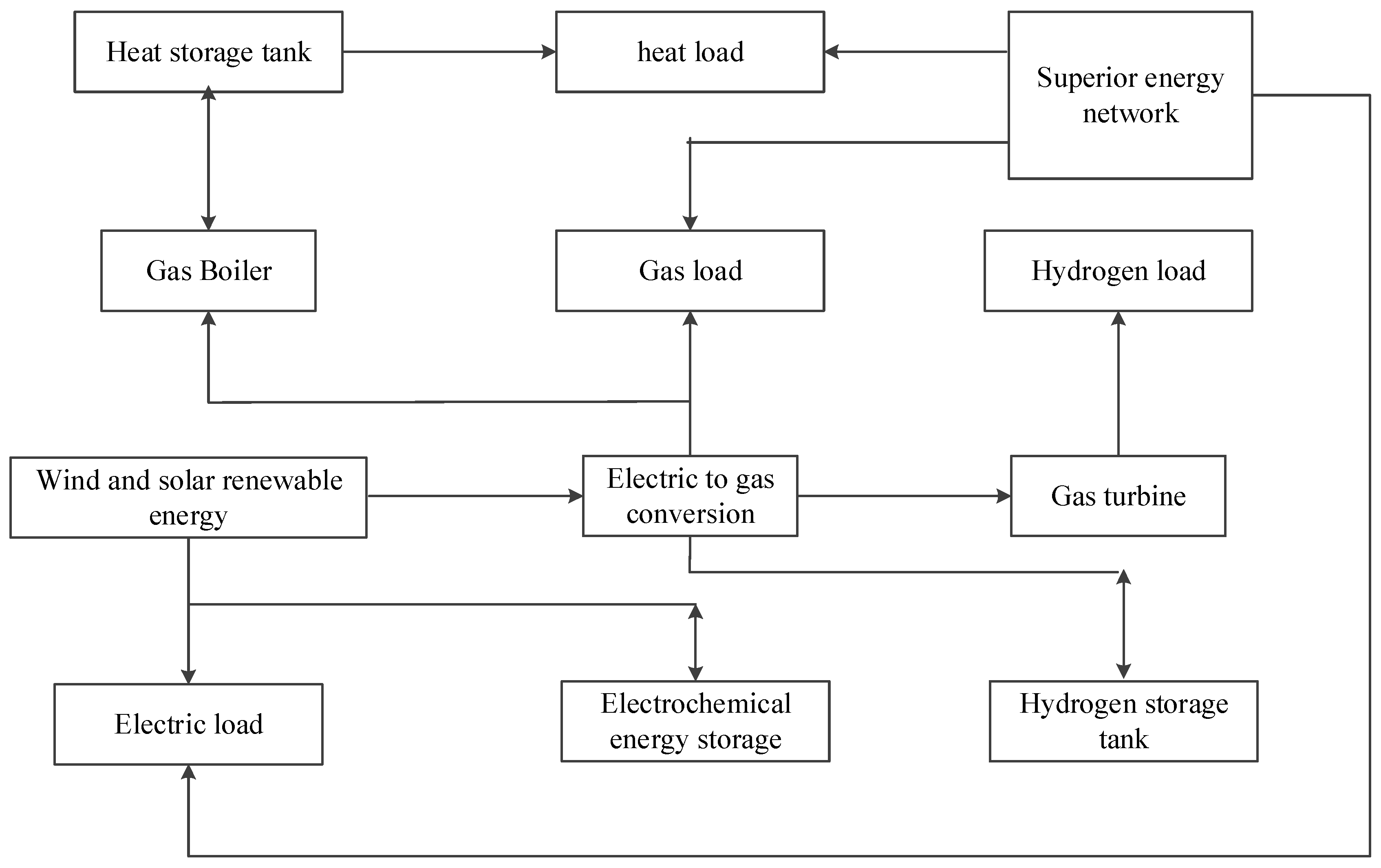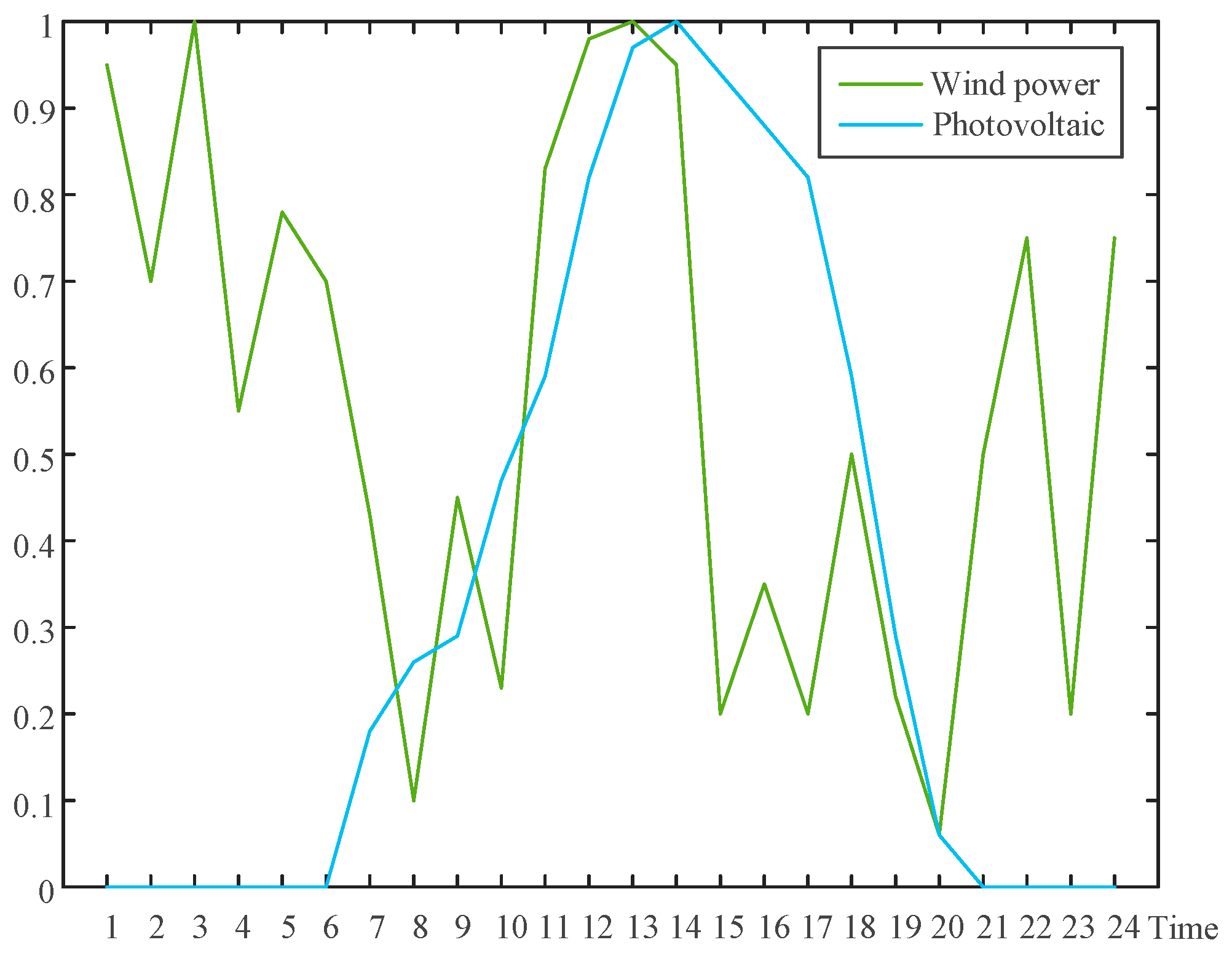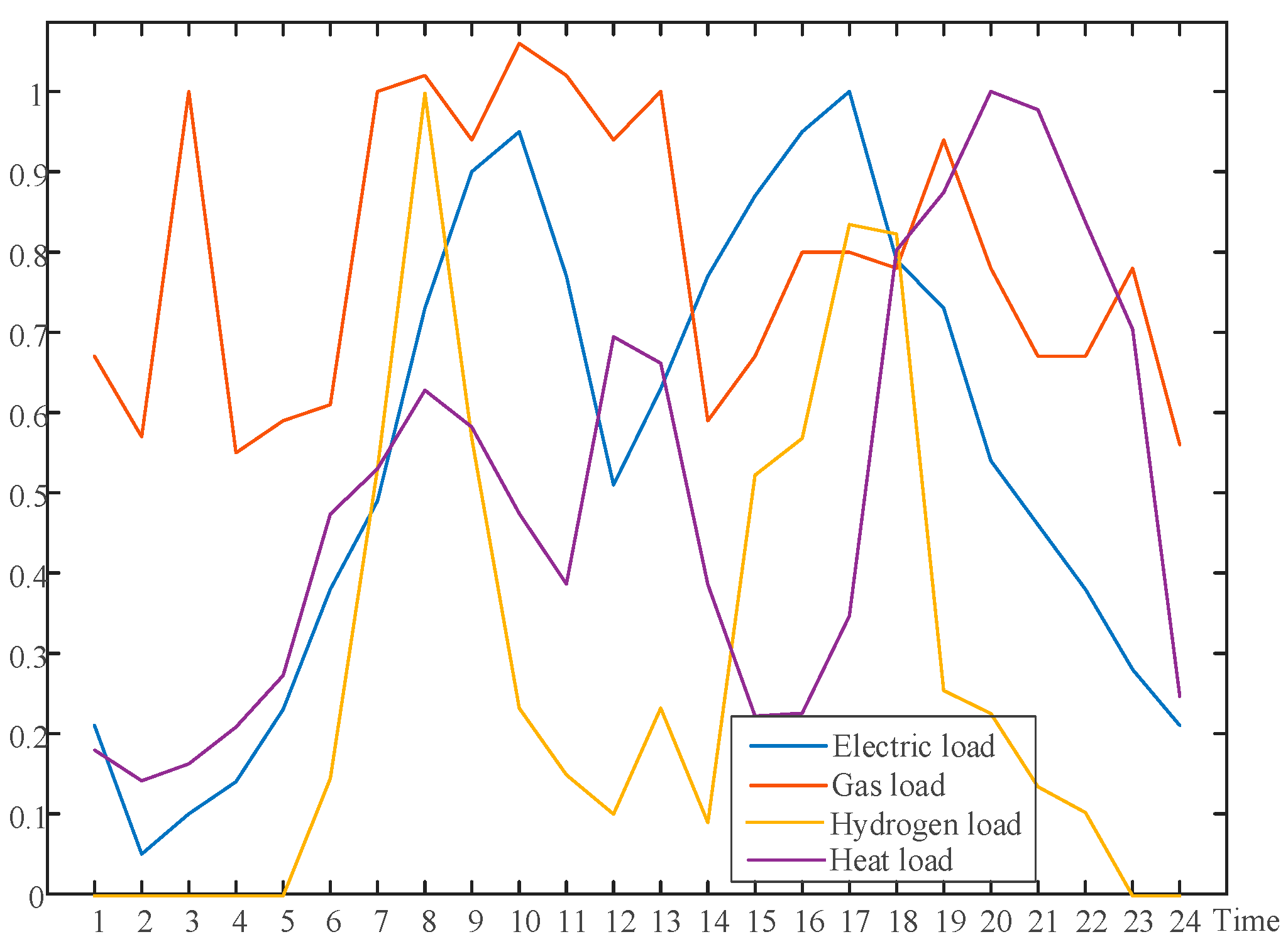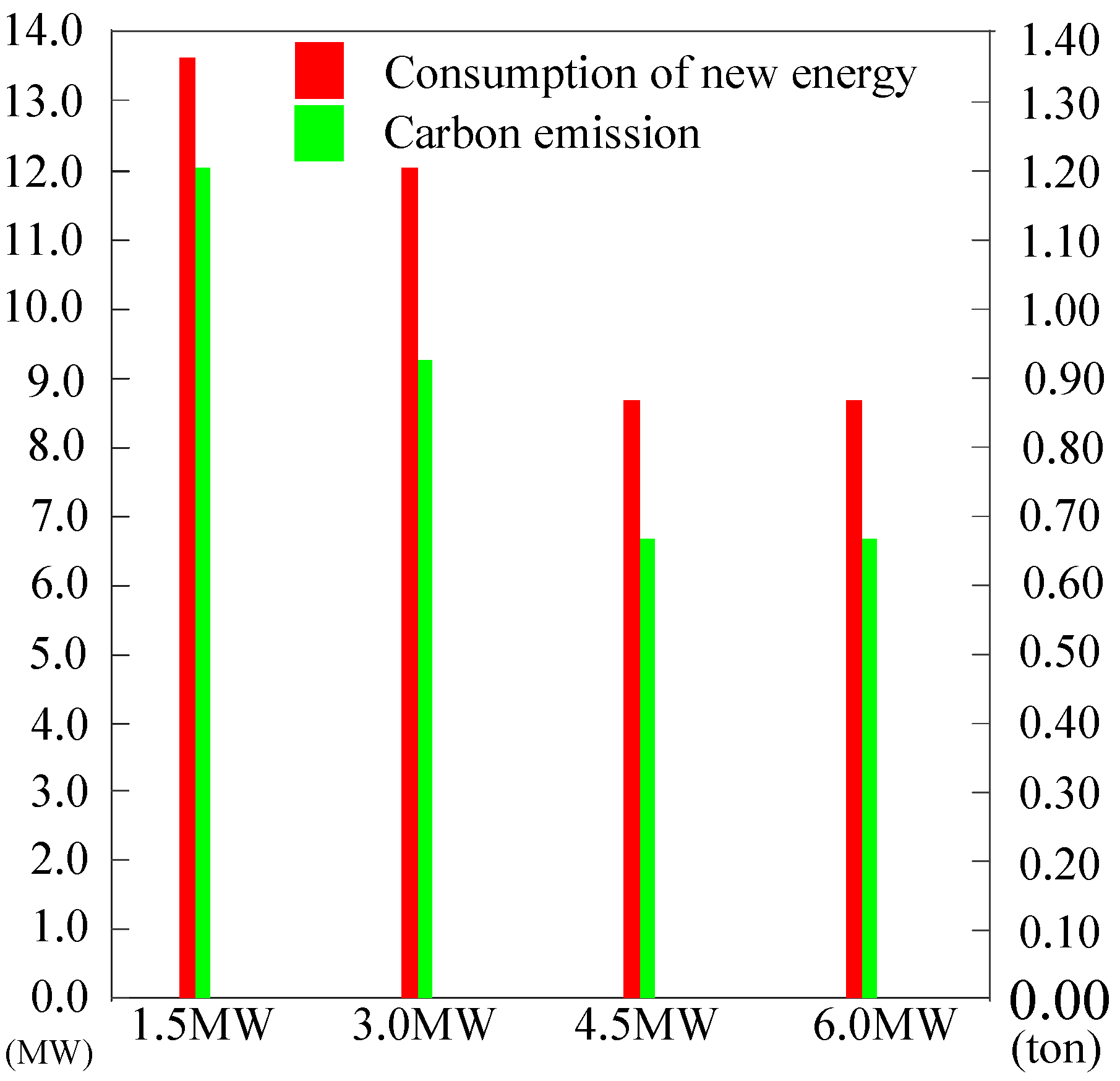Operation Strategy for an Integrated Energy System Considering the Slow Dynamic Response Characteristics of Power-to-Gas Conversion
Abstract
:1. Introduction
2. Electric-to-Gas Operation Model Considering Dynamic Characteristics
3. Optimization Operation Model of the Integrated Energy System
3.1. Objective Function
3.2. Constraint Condition
- (1)
- Power balance constraint
- (2)
- Operational constraints of gas boilers
- (3)
- Operational constraints of heat storage tanks
- (4)
- Operational constraints of electrochemical energy storage
- (5)
- Gas turbine operation constraints
- (6)
- New energy reduction constraints
- (7)
- Constraints on online energy purchasing by superiors
4. Simulation Analysis
4.1. Basic Data
4.2. Analysis of Operating Results
4.3. The Impact of Different Electric-to-Gas Conversion Capacities on Operating Results
5. Conclusions
Author Contributions
Funding
Data Availability Statement
Conflicts of Interest
References
- Liu, S.; Peng, Y.; She, Y.; Liu, Y. Grasp the nettle or retreat: Dynamic effects decomposition of carbon trading policies from a spatial perspective. J. Clean. Prod. 2023, 414, 137788. [Google Scholar] [CrossRef]
- Hou, R.; Li, S.; Wu, M.; Ren, G.; Gao, W.; Khayatnezhad, M.; Gholinia, F. Assessing of impact climate parameters on the gap between hydropower supply and electricity demand by RCPs scenarios and optimized ANN by the improved Pathfinder (IPF) algorithm. Energy 2021, 237, 121621. [Google Scholar] [CrossRef]
- Li, X.; Wang, F.; Al-Razgan, M.; Awwad, E.M.; Abduvaxitovna, S.Z.; Li, Z.; Li, J. Race to environmental sustainability: Can structural change, economic expansion and natural resource consumption effect environmental sustainability? A novel dynamic ARDL simulations approach. Resour. Policy 2023, 86, 104044. [Google Scholar] [CrossRef]
- Liu, L.; Wu, Y.; Wang, Y.; Wu, J.; Fu, S. Exploration of environmentally friendly marine power technology -ammonia/diesel stratified injection. J. Clean. Prod. 2022, 380, 135014. [Google Scholar] [CrossRef]
- Tian, H.; Li, R.; Salah, B.; Thinh, P. Bi-objective optimization and environmental assessment of SOFC-based cogeneration system: Performance evaluation with various organic fluids. Process Saf. Environ. Prot. 2023, 178, 311–330. [Google Scholar] [CrossRef]
- Hu, J.; Zou, Y.; Zhao, Y. Robust operation of hydrogen-fueled power-to-gas system within feasible operating zone considering carbon-dioxide recycling process. Int. J. Hydrog. Energy 2024, 58, 1429–1442. [Google Scholar] [CrossRef]
- Quarton, C.J.; Samsatli, S. Power-to-gas for injection into the gas grid: What can we learn from real-life projects, economic assessments and systems modelling? Renew. Sustain. Energy Rev. 2018, 98, 302–316. [Google Scholar] [CrossRef]
- Walker, S.B.; van Lanen, D.; Mukherjee, U.; Fowler, M. Greenhouse gas emissions reductions from applications of Power-to-Gas in power generation. Sustain. Energy Technol. Assess. 2017, 20, 25–32. [Google Scholar] [CrossRef]
- Bassano, C.; Deiana, P.; Vilardi, G.; Verdone, N. Modeling and economic evaluation of carbon capture and storage technologies integrated into synthetic natural gas and power-to-gas plants. Appl. Energy 2020, 263, 114590. [Google Scholar] [CrossRef]
- Zhong, L.; Yao, E.; Zou, H.; Xi, G. Thermodynamic and economic analysis of a directly solar-driven power-to-methane system by detailed distributed parameter method. Appl. Energy 2022, 312, 118670. [Google Scholar] [CrossRef]
- Choe, C.; Kim, H.; Lim, H. Feasibility study of power-to-gas as simultaneous renewable energy storage and CO2 utilization: Direction toward economic viability of synthetic methane production. Sustain. Energy Technol. Assess. 2023, 57, 103261. [Google Scholar] [CrossRef]
- Buchholz, O.S.; van der Ham, A.G.J.; Veneman, R.; Brilman, D.W.F.; Kersten, S.R.A. Power-to-Gas: Storing Surplus Electrical Energy. A Design Study. Energy Procedia 2014, 63, 7993–8009. [Google Scholar] [CrossRef]
- Fambri, G.; Diaz-Londono, C.; Mazza, A.; Badami, M.; Sihvonen, T.; Weiss, R. Techno-economic analysis of Power-to-Gas plants in a gas and electricity distribution network system with high renewable energy penetration. Appl. Energy 2022, 312, 118743. [Google Scholar] [CrossRef]
- Blanco, H.; Nijs, W.; Ruf, J.; Faaij, A. Potential of Power-to-Methane in the EU energy transition to a low carbon system using cost optimization. Appl. Energy 2018, 232, 323–340. [Google Scholar] [CrossRef]
- McKenna, R.C.; Bchini, Q.; Weinand, J.M.; Michaelis, J.; König, S.; Köppel, W.; Fichtner, W. The future role of Power-to-Gas in the energy transition: Regional and local techno-economic analyses in Baden-Württemberg. Appl. Energy 2018, 212, 386–400. [Google Scholar] [CrossRef]
- Blanco, H.; Faaij, A. A review at the role of storage in energy systems with a focus on Power to Gas and long-term storage. Renew. Sustain. Energy Rev. 2018, 81, 1049–1086. [Google Scholar] [CrossRef]
- Bailera, M.; Lisbona, P.; Romeo, L.M.; Espatolero, S. Power to Gas projects review: Lab, pilot and demo plants for storing renewable energy and CO2. Renew. Sustain. Energy Rev. 2017, 69, 292–312. [Google Scholar] [CrossRef]
- Prabhakaran, P.; Graf, F.; Koeppel, W.; Kolb, T. Modelling and validation of energy systems with dynamically operated Power to Gas plants for gas-based sector coupling in de-central energy hubs. Energy Convers. Manag. 2023, 276, 116534. [Google Scholar] [CrossRef]
- Gorre, J.; Ruoss, F.; Karjunen, H.; Schaffert, J.; Tynjälä, T. Cost benefits of optimizing hydrogen storage and methanation capacities for Power-to-Gas plants in dynamic operation. Appl. Energy 2020, 257, 113967. [Google Scholar] [CrossRef]
- Inkeri, E.; Tynjälä, T.; Karjunen, H. Significance of methanation reactor dynamics on the annual efficiency of power-to-gas -system. Renew. Energy 2021, 163, 1113–1126. [Google Scholar] [CrossRef]
- Giglio, E.; Pirone, R.; Bensaid, S. Dynamic modelling of methanation reactors during start-up and regulation in intermittent power-to-gas applications. Renew. Energy 2021, 170, 1040–1051. [Google Scholar] [CrossRef]
- Zhou, S.; Sun, K.; Wu, Z.; Gu, W.; Wu, G.; Li, Z.; Li, J. Optimized operation method of small and medium-sized integrated energy system for P2G equipment under strong uncertainty. Energy 2020, 199, 117269. [Google Scholar] [CrossRef]
- Zhang, R.; Jiang, T.; Li, G.; Chen, H.; Li, X.; Ning, R. Double layer optimization scheduling of electricity gas integrated energy system considering electricity to gas consumption and wind power. Chin. J. Electr. Eng. 2018, 38, 5668–5678+5924. [Google Scholar]
- Zhang, X.; Zhang, Y. Environment-friendly and economical scheduling optimization for integrated energy system considering power-to-gas technology and carbon capture power plant. J. Clean. Prod. 2020, 276, 123348. [Google Scholar] [CrossRef]
- Ancona, M.A.; Antonioni, G.; Branchini, L.; De Pascale, A.; Melino, F.; Orlandini, V.; Antonucci, V.; Ferraro, M. Renewable Energy Storage System Based on a Power-to-Gas Conversion Process. Energy Procedia 2016, 101, 854–861. [Google Scholar] [CrossRef]
- Luo, F.; Shao, J.; Jiao, Z.; Zhang, T. Research on optimal allocation strategy of multiple energy storage in regional integrated energy system based on operation benefit increment. Int. J. Electr. Power Energy Syst. 2021, 125, 106376. [Google Scholar] [CrossRef]
- Yang, L.; Li, H.; Zhang, H.; Wu, Q.; Cao, X. Stochastic-Distributionally Robust Frequency-Constrained Optimal Planning for an Isolated Microgrid. IEEE Trans. Sustain. Energy 2024. early access. [Google Scholar] [CrossRef]






| Symbol | Numerical Value |
|---|---|
| ηgfg | 0.7 |
| ηchp | 0.6 |
| ηmr | 0.65 |
| γelz | 0.77 |
| βmin | 0.2 |
| Pgrid.max | 1 MW |
| Fgird.max | 1.3 km3 |
| Hgrid.max | 1.5 MW |
| ΔPgfg.min | 0.5 Pgfg.min |
| ΔPgfg.max | 0.8 Pgfg.max |
| Pch,min, Pdis.min | 0.4 MW |
| Pch,max, Pdis.max | 0.4 MW |
| ΔHstor min | 0.2 ΔHstor max |
| , | 0.5 ΔHstor max |
| Fchp.min | 0.2Fchp.max |
| , | 0.5 QHy w |
| , | 0.5 QHy w |
| crene,, ccurt | 0.3 yuan/kW, 0.35 yuan/kW |
| cpower, cgas | 0.4 yuan/kW, 0.68 yuan/km3 |
| cheat | 0.6 yuan/MW |
| cco2 | 100 yuan/ton |
| Scenario | 1 | 2 | 3 |
|---|---|---|---|
| New energy grid connection costs | 0.35 | 0.88 | 0.42 |
| Punishment fees for abandoning scenery | 1.25 | 1.78 | 1.32 |
| Energy supply cost of superior energy network | 0.78 | 2.56 | 1.21 |
| Carbon emission costs | 0.05 | 0.09 | 0.07 |
| Current operating costs | 2.43 | 5.31 | 3.02 |
| Capacity | 1.5 MW | 3.0 MW | 4.5 MW | 6.0 MW |
| Current operating costs | 3.43 | 3.02 | 2.52 | 2.52 |
Disclaimer/Publisher’s Note: The statements, opinions and data contained in all publications are solely those of the individual author(s) and contributor(s) and not of MDPI and/or the editor(s). MDPI and/or the editor(s) disclaim responsibility for any injury to people or property resulting from any ideas, methods, instructions or products referred to in the content. |
© 2024 by the authors. Licensee MDPI, Basel, Switzerland. This article is an open access article distributed under the terms and conditions of the Creative Commons Attribution (CC BY) license (https://creativecommons.org/licenses/by/4.0/).
Share and Cite
Teng, S.; Long, F.; Zou, H. Operation Strategy for an Integrated Energy System Considering the Slow Dynamic Response Characteristics of Power-to-Gas Conversion. Processes 2024, 12, 1277. https://doi.org/10.3390/pr12061277
Teng S, Long F, Zou H. Operation Strategy for an Integrated Energy System Considering the Slow Dynamic Response Characteristics of Power-to-Gas Conversion. Processes. 2024; 12(6):1277. https://doi.org/10.3390/pr12061277
Chicago/Turabian StyleTeng, Shuangquan, Fei Long, and Hongbo Zou. 2024. "Operation Strategy for an Integrated Energy System Considering the Slow Dynamic Response Characteristics of Power-to-Gas Conversion" Processes 12, no. 6: 1277. https://doi.org/10.3390/pr12061277




